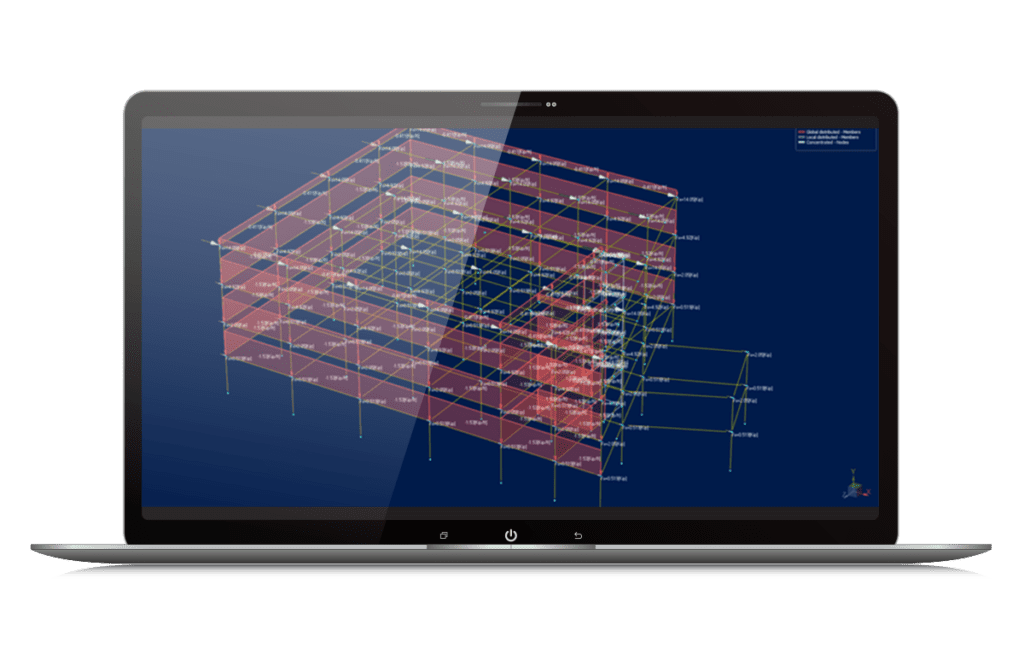
RAM Elements
3D Structural Analysis And Design Software
One Affordable Software
Perform analysis and design of virtually any structure in one affordable application
Perform analysis and design – including 3D finite element analysis – of almost any type of structure or structural component, in one affordable application. RAM Elements is a 3D structural analysis and design software that allows you to quickly perform 3D finite element analysis – of almost any type of structure or structural component. Complete your steel, concrete, cold-formed steel, timber, and masonry projects, regardless of complexity, on time and on budget. It is commonly used to design trusses, continuous beams, and frames of all types, as well as retaining walls, masonry walls, tilt-up walls, shear walls, and footings.

For analysis and design of almost any type of structure or structural component complete with sophisticated design capabilities to help you with your everyday analysis and design needs, RAM Elements delivers a productive and easy-to-use engineering analysis and design toolkit.
UNPARALLELED FLEXIBILITY FROM A SINGLE PROGRAM
RAM Elements offers full 3D finite element analysis and design plus standalone or integrated design modules all in an easy-to-use package. RAM Elements offers features such as designing beams and columns, concrete or masonry shear walls, retaining walls, tilt-up walls, continuous beams, footings, and trusses — all with one familiar, easy-to-learn and use graphical interface. Instead of using a stand-alone finite element program for frames, trusses, and other structures, and specialty programs or spreadsheets for your everyday design needs, use RAM Elements for all these tasks. It eliminates the need to learn different programs for steel, concrete, masonry, wood, or coldformed steel design and the need to purchase additional special purpose products for retaining walls or tilt-up walls. All the functionality you need is in one package.
PROVIDES COMPREHENSIVE STRUCTURAL MODELING
RAM Elements offers finite element analysis and design offerings that can tackle most structural analysis problems. Utilized by thousands of engineering f irms, RAM Elements provides unmatched productivity for modeling, analyzing, designing, and optimizing structural elements and systems.
Numerous modeling capabilities are available to make modeling even complex projects quick and easy. For increased flexibility, a user customizable desktop environment is provided so your favorite commands can be a mouse click away. Physical member modeling features allow users to design as engineers, not finite element specialists. The sophisticated design modules for structural elements such as retaining walls or isolated shear walls can be run as integrated with the finite element model or in stand-alone design mode. With our continuous enhancements, RAM Elements stays up-to-date with code revisions.
QUICKLY DESIGN A SINGLE STRUCTURAL ELEMENT
Effortlessly design a single structural element such as a concrete wall, or utilize its integrated analysis and design capabilities to design these components as part of your 2D or 3D finite element model, which brings all the information into the design module automatically from the model. Current design modules include: trusses, concrete, masonry, and tilt-up walls with or without openings, spread and combined footings, continuous beams, concrete columns with interaction diagrams, and retaining walls.
All reinforced concrete modules will assist you in designing and detailing rebar requirements, perform all the necessary design checks, and produce complete drawings in CAD format along with detailed reports designed to go directly into your structural calculations.
CUSTOMIZABLE
Model quickly and accurately any way you choose using customizable features. RAM Elements allows you to personalize almost every part of the program to your needs or company standards and rules of thumb. With numerous ways to lay out nodes, several ways to model members, quick shell creation, robust import options, and the ability to manipulate every object, you can quickly and accurately model to the detail and obtain the expected results. Customizable toolbars and personalized model views, display options, and unit systems are also available.
This capability allows for templates to be created easily for everyday design structures allowing you to save even more time on every project.


RAM Elements At-A-Glance
TECHNICAL CAPABILITIES
- Dynamic analysis (eigenvalue and response spectra) with CQC, SRSS, and ABS methods for superposition and subspace iteration, Ritz vectors, and Lanczos/Arnoldi for eigen analysis
- Iterative nonlinear P-Delta analysis
- Linear Buckling analysis (Lanczos/Arnoldi or Subspace iteration)
- Tension-only members
- Compression-only springs
- Cable members
- Springs to connect members for semi-rigid joints, setting the rotational stiffness at the member ends
- Flexible or rigid floor diaphragms
- Automatic mass generation with or without the need for rigid diaphragms
- Prismatic and real tapered member analysis (exact stiffness finite element)
- In-plane and out-of-plane stresses in shells
- Allows imposed nodal displacements
- Import of DXF, STAAD.Pro®, RAM Structural System, OpenRE, and SAP2000™ as well as full integration with Structural Synchronizer (ISM) Export to DXF, SDNF, OpenRE, and RAM SBeam
- Hot rolled steel design per AISC 360-22, 2016, 2010 and 2005 (in both ASD or LRFD), AISC 341-16, 2010 and 2005, BS 5950-1:2000, AS 4100-2020 and 1998, CSA S16-19 and 2009, and NBR 8800-08
- Specialty checks for tapered members (AISC DG 25) and member torsion design (AISC DG 9)
- Cold-formed steel design per AISI S100-16, 2012, 2007 and 2001
- Reinforced concrete design per ACI 318-19, 14, 11, 08, and 05, plus BS 8110-1:1997
- Reinforced/unreinforced masonry design per ACI 530-22, 16, 13, 11, 08, and 05 in ASD and SD (latter specifications referred to now as TMS-402
- Wood design (sawed lumber, timber, or glulam) per ANSI/AF&PA NDS-2018 and 2005 in ASD and LRFD
- Reinforced concrete beam, column, and footing design
- Designs for flexure, shear, and torsion for beams
- Designs for axial, bi-axial bending, shear, and slenderness effects for columns
- Seismic provisions for column detailing
- Calculation of lap length, development length, and cutoff points
- Retaining wall design
- Analysis and design of reinforced or unreinforced concrete or masonry retaining walls
- Options to define cantilever, gravity, or restrained retaining walls (with a lateral restraint and pinned or fixed bases)
- Tapered stems or stems with several blocks with thickness and reinforcement changes
- Axial loads on the stem are considered (with or without eccentricity)
- Continuous beam design
- Steel, wood, or concrete beams
- Automatic skip loading
- Tilt-up wall design
- Fixed, pinned, or compression-only springs for the bottom support of the wall
- Simplified or finite element analysis methods
- Automatic design according to the ACI 551 code in addition to ACI 318
- Vertical concentrated and distributed in-plane loads: dead or live, with or without eccentricity lateral distributed out-of-plane loads: wind or seismic
- Isolated or continuous footings option
- Masonry wall design
- Bearing walls, shear walls, columns, and lintels
- Unreinforced or reinforced bearing and/or shear walls
- FEM (finite elements method) analysis of the wall
- Reinforced concrete shear wall design
- Consideration of boundary elements as columns or flanges
- Analysis of the wall with FEM
- Vertical concentrated loads with or without eccentricity
- Vertical distributed in-plane loads
- Spread and combined footing design
- Footing optimization: User-defined stress or soil analysis for height, width, and length
- Global stability checks: Overturning, sliding, and uplift
- Tailored reinforcement and modification flexibility
- Seamless integration with RAM Elements
FREQUENTLY ASKED QUESTIONS
RAM Elements is a 3D structural analysis and design software. RAM Elements helps engineers and designers perform design tasks for steel, concrete, cold-formed steel, timber, and masonry building projects within a single easy-to-learn and use application.
Processor
1.3 GHz or faster processor (x64)
Operating System
Microsoft Windows 10 and 11
RAM
2 GB minimum, 4 GB recommended
Hard Disk
675 MB free disk space for installation
2 GB available for analyzing models
Display
Open GL compatible graphics card with at least 512 MB in video memory, 1024×768 minimum screen resolution.
For the most up-to-date system requirements, visit Bentley Communities.
